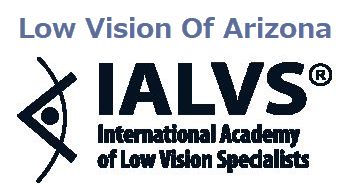
Age-related macular degeneration (AMD) is an eye disease that impairs central vision by progressively damaging the central portion of the retina (the macula). This can make it difficult for patients with AMD to drive, read and carry out other day-to-day tasks.
Fortunately, the low vision team at Low Vision of Arizona helps patients with AMD live full and independent lives. Contact us to learn how we can help you do the same.
Low Vision Glasses and Lenses for Macular Degeneration
Below, you’ll find a list of the most commonly prescribed low vision glasses and lenses for AMD. They work by [maximizing] a patient’s usable vision to increase their visual range or clarity.
Bifocal Glasses
Bifocals contain 2 lens powers in one pair of glasses, helping patients whose near and distance vision both need correction. For people with low vision, the lower section of each lens has a much higher power than regular bifocal lenses. This provides clearer near vision, while the top section improves distance vision.
Prismatic Glasses
Patients with advanced central vision loss can greatly benefit from prismatic glasses, for a number of reasons. The higher power creates magnification, making the print larger and easier to read. In addition, the prism allows for both eyes to be used with these higher-power lenses increasing the ease of reading.
Telescopic Glasses
A pair of prescription telescope binoculars that are mounted onto prescription eyeglasses magnify an image being viewed by both eyes. This can make it easier to watch your grandchildren play sports, enjoy the theater, watch television, recognize faces, appreciate the scenery, explore a museum, read a menu and much more.
Yellow-Tinted Glasses
Reduced contrast sensitivity is a common symptom in early and intermediate AMD that makes it challenging to distinguish between objects of similar shades. For example, seeing the individual steps of a staircase.
Yellow-tinted glasses improve contrast sensitivity but shouldn’t be worn at night or in low-light settings, as they reduce the amount of light that enters the eye.
Magnifying Glasses
Magnifying glasses are excellent for patients with AMD who struggle to focus on near objects or fine print. Magnifying glasses are only suitable for objects that are close to the eyes, whereas other magnifying devices are better for enlarging distant objects.
Bioptic Telescope Glasses
These low vision glasses have miniature telescopes mounted high in the frame with your eyeglass prescription. They give the user the option of having magnification at a distance to see street signs and traffic lights when driving. They are very useful at sporting events, theater and seeing anything at a long distance.
These telescopes, which are placed on only one eye, are ideal for patients with advanced AMD, where one eye has better vision than the other.
High-Powered Lenses
Glasses with high-powered lenses have a high level of magnification, allowing those with significant vision loss to read again. They also allow some patients to read extremely small print like the stock market listings in the newspaper. and can also include a built-in prism. This improves your eyes’ ability to work together, facilitating activities like reading and crafting.
Anti-Glare Lenses
Anti-glare or anti-reflective lenses eliminate unnecessary reflection and glare, allowing patients with AMD to see more clearly (light sensitivity is a common symptom of the disease.) These anti-glare lenses can also reduce eye strain and help protect your eyes from further damage.
Low Vision Aids and Devices for AMD in Gilbert
Whether your AMD is mild or advanced, your low vision optometrist at Low Vision of Arizona is here to provide you with the best vision possible.
Even if you’ve been told that nothing more can be done to improve the quality of your vision, we may be able to help.
To schedule your low vision consultation, contact Low Vision of Arizona in Gilbert today.
Our practice serves patients from Gilbert, Mesa, Phoenix, and Chandler, Arizona and surrounding communities.
Frequently Asked Questions with Dr. Paul L. Woolf
Q: What are the most common forms of low vision?
A:
- Loss of central vision: a blind spot in the center of the vision.
- Loss of peripheral vision (side vision): inability to see to the side, above or below eye level, but perfect vision straight ahead.
- Night blindness: An inability to see clearly at night or in dimly lit environments.
- Blurred vision: out-of-focus objects appear blurry.
- Hazy vision: the feeling that everything is obscured by a fog or haze
Q: What is a low vision optometrist?
A: A low vision optometrist is an eye doctor that can help manage the condition causing low vision while offering support on coping with vision loss. Thanks to their specific training, experience, tools, aids and devices, low-vision optometrists can improve your quality of life and maximize your remaining vision. Call Low Vision of Arizona to schedule your appointment today!
